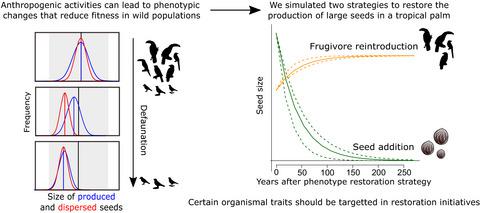当前位置:
X-MOL 学术
›
J. Appl. Ecol.
›
论文详情
Our official English website, www.x-mol.net, welcomes your feedback! (Note: you will need to create a separate account there.)
Rescuing intraspecific variation in human‐impacted environments
Journal of Applied Ecology ( IF 5.7 ) Pub Date : 2020-09-15 , DOI: 10.1111/1365-2664.13764 Carolina da Silva Carvalho 1, 2 , Marília Souza Lucas 1 , Marina Corrêa Côrtes 1
中文翻译:

拯救人类影响环境中的种内变异
更新日期:2020-09-15
Journal of Applied Ecology ( IF 5.7 ) Pub Date : 2020-09-15 , DOI: 10.1111/1365-2664.13764 Carolina da Silva Carvalho 1, 2 , Marília Souza Lucas 1 , Marina Corrêa Côrtes 1
Affiliation

|
- Anthropogenic activities influence ongoing selective regimes leading to changes in phenotypic variation of plants and animals. The reduction of phenotypic variation may decrease populations' ability to cope with environmental changes. To counteract the increasing risk of extinction of affected populations, it is important to rescue intraspecific variability, assuring higher success of establishment and persistence under global changes.
- We evaluated whether it is possible to revert phenotypic changes caused by humans using as study case a bird‐dispersed palm that presents seed size reduction due to defaunation of large‐gaped frugivores. We investigated how defaunation changes the seed size profile of each population by evaluating the coefficient of variation, mean and percentage of large phenotypes of produced and dispersed seed sizes. Simple theoretical models were used to simulate the success of two restoration strategies: (a) direct reintroduction of missing phenotypes that were originally found in the species and (b) reintroduction of large‐bodied frugivores to restore the ecological function of large‐seed dispersal. Here we discuss the importance of rescuing phenotype states in restoration strategies.
- We found that defaunation changes the seed size profile by reducing the size of produced and dispersed seeds. By adding missing phenotypes one time, population mean seed size decreased back to phenotypically depauperated scenarios in eight generations. Conversely, large seed sizes could be rescued in approximately five generations after seed dispersal processes generated by large seed dispersers were re‐established.
- To rescue and sustain phenotypes such as large seed sizes in palm populations is necessary to restore the seed dispersal processes by large frugivores or add missing phenotypes continuously over time. The restoration of the seed dispersal processes by large frugivores has additional value over seed addition because it would benefit other bird‐dispersed species and, therefore, may be crucial to face ongoing global change scenarios.
- Synthesis and applications. Defaunation leads to character displacement within decades, having impact on populations, species and ecosystems. To prevent species extinction is paramount that phenotype variation is preserved. We propose the inclusion of phenotype restoration of wild populations as a goal for restoration framework.
中文翻译:

拯救人类影响环境中的种内变异
- 人为活动影响正在进行的选择机制,导致动植物表型变异的变化。表型变异的减少可能会降低人群应对环境变化的能力。为了抵消受影响人群灭绝风险的增加,重要的是挽救种内变异,确保在全球变化下建立和持久性取得更大的成功。
- 我们评估了是否有可能使用鸟分散的棕榈作为研究案例来还原人类造成的表型变化,该棕榈分散的棕榈由于裂隙较大的节食动物的消瘦而导致种子尺寸减小。我们通过评估变异系数,产生和分散的种子大小的大表型的平均值,均值和百分比,研究了去污如何改变每个种群的种子大小。简单的理论模型用于模拟两种恢复策略的成功:(a)直接重新引入最初在物种中发现的缺失表型;(b)重新引入大果蝇,以恢复大种子散布的生态功能。在这里,我们讨论了在恢复策略中挽救表型状态的重要性。
- 我们发现,脱胶通过减少产生和分散的种子的大小而改变了种子的大小。通过一次添加缺失的表型,种群平均种子大小在八代后又减小到表型消失的情况。相反,在重新建立由大型种子分散器产生的种子分散过程后,大约五代可以挽救大种子。
- 为了挽救和维持表型,例如棕榈种群中的大种子大小,有必要通过大型节食动物恢复种子的传播过程,或者随着时间的推移不断添加缺失的表型。大果蝇恢复种子传播过程比添加种子具有更高的价值,因为它将使其他鸟类分散的物种受益,因此对于面对持续的全球变化情况可能至关重要。
- 综合与应用。毁灭导致人物角色在数十年内流离失所,对种群,物种和生态系统产生影响。为了防止物种灭绝,保留表型变异至关重要。我们提议将野生种群的表型恢复作为恢复框架的目标。



























 京公网安备 11010802027423号
京公网安备 11010802027423号